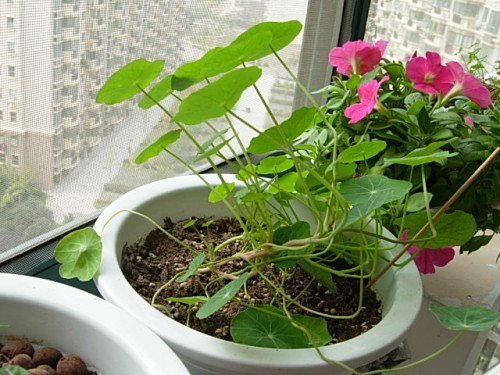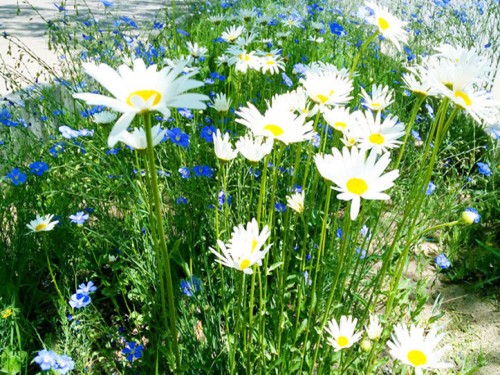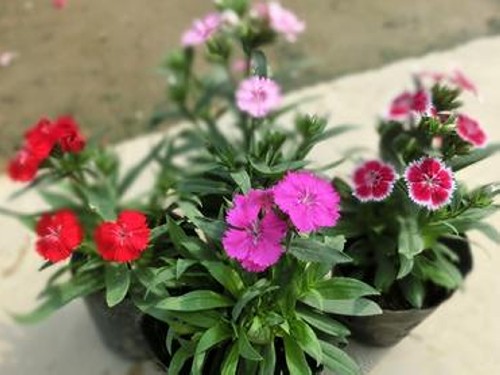Illustration of planting method of potted Trollius chinensis
The stems of nasturtiums are creeping, and generally must be strengthened by erection. If they are allowed to grow naturally, the stems will be too long, affecting the viewing. In order to control the unlimited growth of its stem and vine, when it enters the initial flowering stage and its stem and vine has grown to 30-40 cm, it is sprayed with 100PPM paclobutrazol solution on the leaves to promote its dwarfing. After spraying three days can be effective, the main vine thickened, the top spread long slow, the flowers on the side vine opened one after another, quite beautiful.

For flower friends who want to plant nasturtium, it is best to see an illustration of nasturtium planting method. This article is a diagram of nasturtium seed method summarized by flower friends according to their own planting experience. I hope it can help flower friends plant nasturtium.
Although nasturtium is a perennial plant, but because nasturtium is not resistant to high temperature, so often do one or two years of planting, a few years down I tried spring sowing, autumn sowing, winter sowing, each time the effect is different, as follows:
Spring sowing: short growth cycle, thin strips, fine and few seeds;
Autumn sowing: suitable for most areas, although September, October sowing, to wait until February, March of the following year to see flowers, but the growth process is relatively smooth, maintenance is relatively easy;
Winter sowing: the flowering period is basically similar to spring sowing, but due to the difficulty of seedling maintenance in winter sowing, it can be tried in warm areas in the south and warm areas in the north.
The following is an example of Zhejiang, illustrating the whole process:
1. In early October, the temperature is basically between 22-24℃, and the autumn is crisp, which is most suitable for sowing.
2. The germination period of nasturtium seeds is only 5 years, and the germination rate of old seeds is low, so try to choose fresh seeds when sowing.
3. Before sowing, soak the seeds in warm or cold water for 24 hours, gently peel off the outer skin, and then germinate with paper towel.
4. Germination must be carried out with fragrance-free tissue box purified water (cooled boiled water is also available), generally 2-7 days or so to expose the cusps (varieties, temperature differences in germination time)
5, seedling strongly recommend plastic transparent disposable cup, wrapped with thick paper outside the cup, to prevent direct sunlight roots (recommended reasons for convenient water and fertilizer management, intuitive relationship growth).
6. When the root system is basically full of water cups, transplanting and planting can be carried out, and pots of 18-20 cm can be used for planting.
7. When the plant has 4 true leaves, perform the first topping, remove 2 true leaves, leave 2, and continue to grow. If the plant branches well, you only need to pick it once more, but some varieties have weak branching ability and need to pick it many times to achieve the ideal column shape. At this time, you can wait for the lateral branches to grow 4 true leaves. When the second topping is performed.
8. The demand for nitrogen fertilizer in the growth process of nasturtium is relatively weak. In order to make it bloom early and bloom more, it is necessary to irrigate roots or spray leaves with potassium dihydrogen phosphate diluent every 10 days during the growth period or alternately.
9. After flowering, if no seeds are left, the residual flowers should be subtracted in time to facilitate the formation of new flower buds.
10. When planting outdoors in warm spring, it is easy to bear seeds. Indoor maintenance requires artificial pollination. Artificial pollination is suitable for sunny morning. When stamens pop out pollen and pistil is "human" type, apply pollen to pistil. The same flower and cross flower can be pollinated. Pollen will wither rapidly after pollination. When the flower stalk is curved and spiral, it indicates successful pollination.
11, mature seeds will fall down on their own, at this time the seeds will be dried in the sun, stored in the shade can be.
Nasturtium like warm and humid, sunny environment, growth temperature of 18-24℃, high temperature in summer is not easy to bloom. Intolerant to waterlogging, not cold. Loves fertile, well-drained soil. According to these growth habits, when you pay the hard work, nasturtium will certainly show her most beautiful side in front of you. At this time, your joy of success cannot be expressed in words.
Time: 2019-05-25 Click:
- Prev

Planting method of Chrysanthemum morifolium
The trees on both sides of the road are covered with Compositae flowers, and the brain automatically pops out: wild hair and delicate fragrance (I can still remember, it seems that the high school Chinese class is not in vain). Today's protagonist is Dabin Chrysanthemum. Dabin chrysanthemum has a long flowering period, probably from April to June.
- Next

Planting method of potted colorful Carnation Flower
Colorful carnation, alias: Phyllostachys pubescens, American carnation, brocade, perennial herbs, 30-60 cm high, cold-resistant but not resistant to heat, can be planted from late spring to mid-autumn (the temperature is above 10 degrees, regardless of the season). Gardens can be used in flower beds, flower borders, flower beds or potted plants
Related
- Fuxing push coffee new agricultural production and marketing class: lack of small-scale processing plants
- Jujube rice field leisure farm deep ploughing Yilan for five years to create a space for organic food and play
- Nongyu Farm-A trial of organic papaya for brave women with advanced technology
- Four points for attention in the prevention and control of diseases and insect pests of edible fungi
- How to add nutrient solution to Edible Fungi
- Is there any good way to control edible fungus mites?
- Open Inoculation Technology of Edible Fungi
- Is there any clever way to use fertilizer for edible fungus in winter?
- What agents are used to kill the pathogens of edible fungi in the mushroom shed?
- Rapid drying of Edible Fungi

